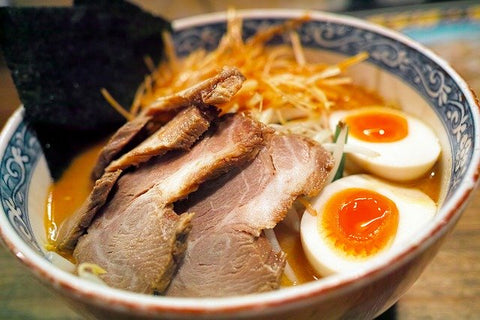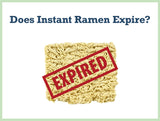
No - ramen is a Japanese food.
But the root of ramen is from Chinese noodles called “lamian".

Let me explain...
1. Ramen vs Lamian: Why are they different?
2. How these noodles taste different
3. Kansui - unknown ingredient of ramen noodles
4. How ramen and lamian noodles look different
5. The one that is significantly different is the soup
6. The actual history of ramen
7. The word “Ramen" is always used to refer to this in the world

1. Ramen vs Lamian: Why are they different?
Ramen and lamian are very different types of food, even though lamian was the basis for the creation of ramen.
In Chinese, "la" means "to pull" and "mian" is a food product made from wheat dough including noodles.
So, what this means is lamian is literally translated into hand-pulled noodles.

Have you ever watched a Chinese chef pulling noodles like this?
It is both admirable and entertaining.
For ramen, you don't hand-pull the dough. You make the dough flat, and cut it into long, thin noodle-like strands.
Let’s recap: Japanese ramen noodles is used to refer to the generic noodles made of wheat, while lamian refers specifically to hand- pulled Chinese noodles.
2. How these noodles taste different
As I mentioned, Japanese ramen is not made by hand-pulling, but by slicing or cutting strands from rolled dough.
Usually, you will use a machine to aid in the process of making ramen noodles:
Mixing flour, making dough, flattening dough, combining two flat pieces of dough into one by pressing, cutting into strand shape etc..
Doing this process will help ramen noodles achieve a tougher and chewier texture.
This nice chewiness of ramen noodles makes me feel satisfied and content.
Do you think Chinese lamian has the same texture?
Nope!
Lamian noodles are a lot softer than ramen noodles.
Do you know why?
Because you use oil while you hand pull lamian.
Oil makes expanding and pulling noodles easier.

3. Kansui - unknown ingredient of ramen noodles
What are ramen noodles? It is actually quite simple.
Ramen noodles are a mixture of wheat flour, water, and kansui.
Kansui is an alkaline solution (usually sodium carbonate or potassium carbonate).

Kansui makes noodles...
1. Yellow,
2. Chewy, Smooth, and
3. Gives it its distinct ramen noodle flavor.
The biggest difference between ramen and lamian is…
You use kansui in order to make ramen, but you don't use kansui for lamian.

4. How ramen and lamian noodles look different
Yes, they look different.
Ramen noodles are straight or wavy.
But lamian noodles are always straight.
And lamian noodles are thinner than regular ramen noodles.
But lamian noodles taste like udon and somen.
If you have only ever eaten ramen, and try laimian for the first time, you may think…
"Is the texture supposed to be like this?"
The noodle texture of these two noodles are actually very different!

5. The one that is significantly different is the soup
In Japan, usually, the priority of elements of a ramen dish goes like this...
Soup > Noodles > Toppings
For example:
When you choose a ramen shop for meal time, you start considering the ramen’s broth.
Shoyu, shio, tonkotsu, miso,
or...
Fish base, clam base, chicken base, pork bone base etc..

However, for Chinese noodles, priority goes like this...
Toppings > Noodles > Soup
Take a look at the 5 biggest Chinese noodle types:
Hui mian, dandan noodles, hot dry noodles, zhajiangmian, and knife-cut noodles.
Only hui mian and knife-cut noodles come with soup.
I know many types of Chinese noodles with a delicious soup base, but the taste of the soup usually comes from their toppings.

I can say the culture of dashi (soup stock) is more developed in Japan.
So, the priority of the soup differs between ramen and lamian.

6. The actual history of ramen
Fact:
The origin of ramen is from Chinese noodles.

The oldest record of Chinese noodles in Japan is...
In 1697, Zhu Zhiyu treated his home town noodles to Tokugawa Mitsukuni.
Zhu Zhiyu was a scholar of Confucianism from the Ming dynasty and Edo Japan.
And Tokugawa Mitsukuni was the feudal lord of Mito, Japan.
Or...
In 1488, a Japanese monk made noodles using Chinese recipe and treated his visitor.
However, ramen couldn't be popular in Japan until the 19th century.
The important and exhilarating moment of ramen was the opening of Rairaiken in Asakusa, Tokyo.

Do you know Japanese people mix up the “L” and the “R” sound?
(Sometimes I still have trouble with that!)
And that is why ramen is spelled with an “R” instead of “L".

7. The word “Ramen" is always used to refer to this in the world
Did you know that Chinese people don’t consider the Chinese food in Japan authentic?
When the Chinese see the menu of a Chinese restaurant in Japan, they are confused.
Because they think “What is this?!"
Localized Chinese food in Japan is adjusted for the taste preference of Japanese customers.
So many Chinese people may think this altered cuisine is strange!
However, they enjoy eating ramen and they are satisfied.
Do you know why?
Because they think ramen is considered Japanese food.
All over the world, the word “ramen" is always used to refer to Japanese-style ramen noodles.

Ramen has become a popular food in Japan.
And over 100 years of adaptation and improvement,
Ramen noodles have evolved to the point that they have become a completely distinct and different dish from the original Chinese noodles.
Ramen dishes are unique Japanese food.
And they have been making people around the world delighted and ecstatic.

If ramen or any other types of Japanese style noodles and soup is comfort food for you, you might be thinking that you need ramen bowls.
Ramen bowls are perfect for a large bowl of ramen.
They are big enough to pile on the fixings, they are durable, and best of all, they look beautiful.
Share a bowl of warm, hearty home cooked ramen with your family, friends and loved ones for your ramen night.
Or when you order take out, transfer the noodles from those awful looking containers.
You and your family will be so excited and can’t wait until your next ramen night to use these bowls!
About the Author

"I am from Ibaraki, Japan.
Ramen is great! It can bring you a sense of happiness and satisfaction that no other food can. I have been eating ramen for 30 years.
If there is no ramen, my life would be miserable.
Ten years ago, I worked as an office worker. The job was really stressful - excessive working hours, low wages, unpaid overtime work, and constantly being yelled at by my boss.
I was new and alone, no girlfriend, no friends, and felt very lonely.
My only oasis was the ramen shop near the office. For me, the ramen chef there was literally an angel. I saw a halo on his head. (No joke)
Tonkotsu shoyu ramen was my all-time favorite. He made ramen with broth chock-full of umami flavor, nice chewy handmade noodles, and tender chashu.
My greatest dream is connect people with ramen through my blog. I want to share a lot of interesting and funny stories and ramen trivia with you.
Knowing more about ramen can help you appreciate your ramen and make it taste extra delicious."
I tried to find out the real meaning of ramen. Even I didn't expect what I had found.







Leave a comment